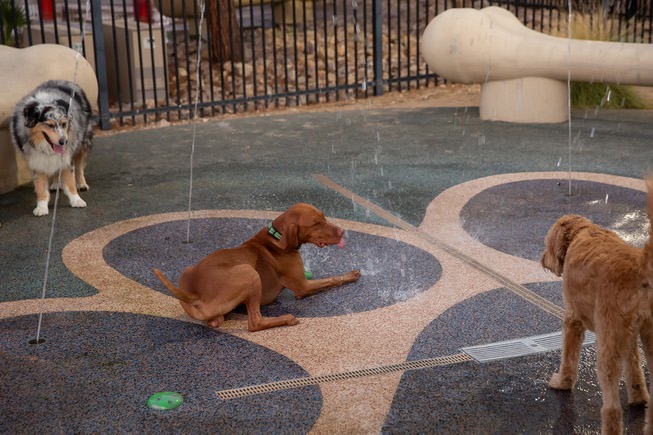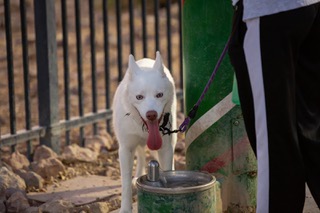
From left, Hunter, a 2-year old Australian Sheep Dog, Arlo, a 7-month Hungarian Vizsla, and Gigi, a 2-year old Golden Doodle, enjoy the splash pad at The Bark Park in Henderson after sundown Thursday July 27, 2023. Due to high temperatures in the Vegas valley, dog owners are having to wait till later in the evening or early in the morning to walk their dogs.
Saturday, July 29, 2023 | 2 a.m.
Chester greets nearly every human and dog that enters the gate at Henderson’s Bark Park.
The 1-year-old labradoodle loves making new friends, says its owner, Jeff Kruger, as Chester romps with a golden retriever.
Kruger has been visiting the park almost daily for more than five years. He’s a part of a group of neighborhood regulars. Owners lounge in folding chairs and chat while the dogs run and roll with new and old friends.
The routine amongst the group is dependable but a weeks-long heat wave with temperatures well above 100 degrees has the regulars making some changes to their lifestyles.
Erick Andrade, owner of a petite German shorthaired pointer named Sota, said he typically visits before sunset, but the heat wave has pushed his visits back to about sunset.
Pet owners around the valley have needed to change routines during the heat wave and vets say their clients are doing a fairly good job.
Dr. Thearayouk Keo, a veterinarian at the Edge Pet Hospital in Henderson, said he’s only seen a few cases of dogs being overheated this summer. None of the cases were serious and all the dogs recovered.
“The clients have been vigilant about taking care of their dogs,” Keo said. “A lot of people have been aware that the heat has been pretty extreme.”
While temperatures have been over 100 degrees, pet owners should use caution anytime the temperatures are more than 90 degrees, he said.
Pet owners should refrain from activity outside with their dogs during daylight hours, Keo said. He said the best time would be late evening or early morning before the sun rises. It would be best to wait a couple hours after the sun sets because the ground is often still hot at sunset, he said.
Activity time should also be limited, even during evening and early-morning play, he said.
Older dogs and some breeds have more trouble with heat than others, he said. This includes dogs with smaller snouts such as Boston terriers, pugs, French bulldogs and shih tzus.
“Their airways are much smaller and they have a harder time bringing in air,” Keo said.
Pet owners with these breeds should bring water and a spray bottle to mist the dogs when outdoors, he said. Owners also shouldn’t use a collar but instead a harness to keep from further restricting the airflow, he said.
Wetting down a dog’s paws, belly and head prior and during outdoor play is another way to keep pets cool, he said.
The Humane Society says signs of heatstroke in a dog include heavy panting, glazed eyes, a rapid heartbeat, difficulty breathing, excessive thirst and vomiting. If an owner suspects heatstroke, a dog’s temperature should be taken immediately. Anything more than 104 degrees is considered an immediate emergency in need of a veterinary visit.
Keo suggests owners work to lower the dog’s temperature while making their way to a vet by using cool water on their paws, belly, underarms and head. Owners should not use ice baths to cool a dog because it could send a dog into hyperthermia, he said. The temperature should instead be brought down slowly.
For the most part, pet owners in the valley are heeding the warnings about heat but Clark County Animal Control is responding to hundreds of weekly calls regarding dogs in stress because of heat.
James Andersen, Clark County Chief of Animal Control, said a majority of the calls are for dogs kept by owners outside without proper shelter or cooling options, and dogs left in cars.
“Every time it gets very hot for extended periods of time, our call volume increases,” Andersen said. “We have a longer period than normal and it certainly makes those calls increase more.”
When there is an excess heat warning, dog owners are required to provide supplemental cooling if the pet is in their yard, Andersen said. He said this could be a misting system or kiddie pool. The dogs also should have access to water to drink and shade of some sort.
The Humane Society states that dog houses, with no airflow, are not an adequate shelter for dogs during high heat. It says the homes are hotter inside than outside.
“People leaving dogs in cars is our No. 1 killer of animals right now,” Andersen said.
Temperatures can rise fast in a car, even during a minute trip into a store, he said.
“Those animals can go into heat distress pretty quick,” Andersen said.
The Human Society suggests that anyone who sees an animal in a vehicle alone should call 911 or Animal Control immediately.
Local vets say there are other dangers pets can face during high heat that aren’t immediately deadly but could cause long-term harm.
For example, high exposure to UV light can be harmful to dogs’ eyes, including for dogs bred for colder environments, such as huskies and malamutes, Keo said. He said it can cause immediate irritation and lead to cancer in the long run.
Some dog owners use goggles to block UV during times of year or day when the UV index is higher, he said.
Sunburn and cancer can also be an issue for dogs with light pigmented noses or skin, Keo said.
To avoid this, pets that are groomed should not be shaved close to the skin. He said dogs should keep about an inch of fur to block sun exposure.
Dr. Sureet Ghuman of Sun City Animal Hospital said light-breed dogs such as pit bulls with pink skin are also prone to sunburn and skin cancer.
Some owners use a T-shirt on the dogs, if they are going to be outside for a while, she said.
Another tool pet owners use during hot days is a cooling vest, she said.
An important tip is knowing your dog and paying attention, Ghuman said.
“Even in the early morning and late at night, you don’t need to be going on crazy long walks,” Ghuman said. “Always keep water with you. Pay attention to your dog. They will let you know if they can’t go any farther.”
Another concern for dogs during high heat, Ghuman said, is hot asphalt. She tested the road near her house recently to find it at 167 degrees.
“That will very quickly burn a dog’s paws,” she said. “Walk in the grass, walk in shaded areas, late at night and early morning.”
Keo also advocated for dog shoes for any dog that tolerates them. He recently treated a dog that spent the day hiking in the Red Rock Canyon National Conservation Area with its owner.
“The loose rock was hot,” Keo said. “All four paws were torn on the main pads.”
Shoes are also a way to protect from the sharp rock often used for landscaping in the area, he said.
Ghuman said during heat waves, pet owners should find a way to enrich their dog’s play inside. This could be playing ball or tug of war, she said.
High-energy dogs might need a puzzle toy that uses treats as rewards. Lick mats filled with food such as pumpkin and then thrown in the freezer as a treat to lick later, can help keep a dog occupied, she said.
Not long after 8 p.m. Wednesday, Sota, the pointer, hovered around his owner, indicating she was done for the night as temperatures lingered at about 105 degrees. Attentive to his dog’s behavior, Andrade decided it was time to head home.
Soon after, Chester was panting at Kruger’s feet and the pair started to pack up for home and air conditioning, and likely Chester’s second-favorite pastime — watching television commercials. His favorites are for toilet paper, Kruger said as he showed a video of Chester intensely sitting at full attention watching one at home.

